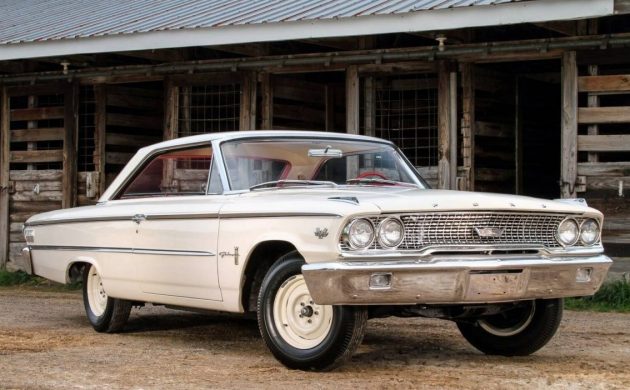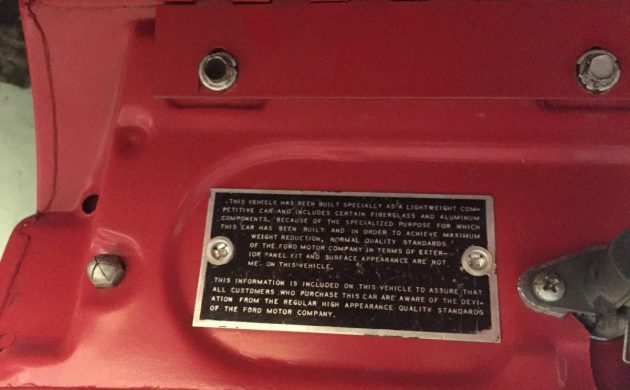There was once a time when car manufacturers were heavily involved in all facets of motorsport. Today they tend to function mostly as engine suppliers for various categories. In days gone by, they would manufacture full factory specials designed for competition use. It is against this background that Ford produced the 1963 Galaxie 500 Lightweight. This was a car designed explicitly as a drag-racer, but it could legally be driven on the road. Only 212 examples were ever built, and they have become more desirable with each passing year. This car is an original survivor, and it has a mere 16,000 miles showing on its odometer. It is located in Mason, Michigan, and has just been offered for sale here at Hemmings. You can secure this monster by handing the owner $145,000.
The listing refers to this car as being 1-of-211, but all of the information I have talked about 212 cars being built. Then again, what is one car between friends? The owner admits that the Galaxie did undergo a repaint in its original Corinthian White back in the late 1960s or early 1970s, but the body and paint have remained untouched since. It spent the years from 1982 until 2017 in storage, and it has emerged in fantastic condition. The paint remains beautifully preserved, while the panels are laser straight. Rust is not an issue with the Galaxie, with the underside of the vehicle featuring little more than the occasional light dusting of surface corrosion. The trim, chrome, and glass are all in first-rate condition. The Lightweight rolls on its original 15″x5½” Kelsey Hayes steel wheels.
A standard Galaxie 500 Fastback tipped the scales at around 4,150lbs, which made it a heavy car. Ford went through an extensive program designed to get as much weight as possible out of the car, but it still needed to be safe for use on the open road. The bodies were built with no sound deadening or seam sealer, while the front fenders, the fender liners, the hood, and the trunk were all replaced with fiberglass items. Ford made extensive use of aluminum throughout the car. The bumpers and bumper brackets were made from this material, as was the bell housing and the case for the T-10 manual transmission, which was standard equipment in these cars. The regular front bench seat made way for a set of lightweight Bostrum items, while the floor was covered by a rubber mat. Anything that was considered surplus to requirements was deleted during the build process. This included the radio, heater, ashtrays, armrests, clock, dome light, hood springs, and the trunk torsion springs. Even the sun visors were made from a thinner grade of cardboard. All of this effort produced results because this leaner, meaner Galaxie now weighed in at around 3,480lbs.
The Galaxie is a numbers-matching car. When it was removed from storage, the original drivetrain was thoroughly inspected, and the engine was treated to a rebuild. This process included returning the original carburetors to Holley for a rebuild. The result of all of this effort is a car that is said to run and drive perfectly. You will find a YouTube clip at the bottom of this article. It provides a walk-around and also allows us to hear that engine running. It sounds as clean and crisp as the day it was born. The mechanical configuration of these Lightweights was proof positive that Ford was serious about success in drag-racing. Power was provided by an R-Code 427ci V8, which was backed by a 4-speed aluminum-case T-10 transmission. The power then found its way to a 4.11 open rear end. The engine was topped in this case by a low-riser intake and dual-quad Holley carburetors. Ford claimed an “official” output figure of 425hp, but as was often the case, this figure has always considered to be conservative. Many sources believe that somewhere around 500 hp would be closer to the mark.
As previously mentioned, everything that was considered surplus to requirements was removed from the Galaxie. This left a utilitarian interior, and thanks to the lack of carpet and sound deadening, one that was also noisy on the open road. Ford didn’t consider this an issue because they envisaged that these cars would only ever be driven in a straight line and that each journey would only be about a ¼ mile in duration. The interior of this Galaxie is original and unrestored. The upholstery is as it left the factory, while the rubber mat on the floor is still in good condition. The bucket seats have a bit of wear and stretching, but given this car’s survivor status, they don’t need to be touched. The rear seat looks like it has never been used.
Life in 1963 was far less complicated than it is today. Don’t take my word for it. Take a look at this Galaxie Lightweight, and then try to imagine Ford building an equivalent car today for the same purpose. There would be so many legislative and regulatory hoops to jump through that the effort wouldn’t be justified. That is what makes cars like this so unique. They hail from a time when manufacturers didn’t just operate as engine suppliers in motorsport. This was an era when manufacturers were “hands-on” in the process. The owner is asking $145,000 for this car, and something tells me that he won’t have a lot of trouble getting it.












Big differential in wgt. 670 pds. That’s 4 passengers weighing 164 pds. + 3.5 pds. ea. of clothing. I realize this lightweight is “bone stock.”Anyone lucky enough to own one for track or street use would source wider tires out back with 500 deep breathing ponies under your right foot and fun-stick coming up out of the floorboard it’s amazing that it has an open differential with the 4:11 gears.
All that is required on this one is the period rear facing hood blister. :-)
Nah, leave it as sleeper style without any hood scoops or blisters. This is one car that deserves to be as clean as possible IMO.
First thing I thought 👍Thunderbolt style
I real piece of automotive history. Would have loved to hear that 427 opened up in the video. The sound of those engines at full power makes me tingle.
Adam, excellent write-up. Especially the last paragraph, which illustrates how this sort of factory vehicle could never happen today. Which makes me even more appreciative of the two recent iterations of the Ford GT. That they actually came to be is quite an accomplishment.
As alphasud said, a real piece of automotive history.
Chevy, Ford & Dodge are still occasionally building drag and road race specials.
Though not street legal, Chevrolet makes a run of COPO drag race special Camaros every year. While not quite as radical as the 60’s factory light weight drag cars, Chevrolet used the same concept for their 2014 Z28 street legal, lighter weight, track day version of the Camaro. The 2018 Dodge Challenger Demon was (barely) street legal. Because of the Demon’s standard drag radials, and other drag racing equipment, Dodge required buyers to sign a liability waiver. Not to be left out, Ford offered the light weight SVT Cobra R in 2000, which was not available with a radio, air conditioning or rear seats. I think Ford may have also offered a stripped down Mustang around 10 or 12 years ago, for use in SCCA racing or the IMSA Continental Tire Series?
Because of Federal emission and safety regulations, it’s harder for automakers to build things like this light weight Galaxie today, but thankfully they still manage to pull it off occasionally.
The pure street versions of this car weren’t exactly slow. They showed up at the smaller drag strips and cleaned our clocks.
My dad had stories about these and regular Galaxies prepped by Tasca leaving a bunch of “modified” cars in the dust…including my father. Lol.
Ford tried to reenter drag racing Just last year, and came up with the Ford Culturally Diverse Green Motor Vehicle, aka the spectacular Ford Soyboy. Unfortunately, market research revealed that everyone preferred a Yugo, which was twice as fast.
A sweet machine.
Its definitely nice that no rods were through the block leaving the Christmas tree lights.
I hope the next owner will take it out from under the garage covers every now and then to run the ponies and blow the carbon out with a little rubber left on a country road 👀👍
Just Perfect.
Beautiful specimen! I wonder why these cars were equipped with open rear ends?
the rear ends were 4 pinion and would launch equally with a small air pressure difference.
Just a guess, but the open diff might be related to avoiding warranty claims.
Holman and Moody must be looking down with sly smiles. I actually touched one of these. I was 16. It was like touching a cheerleader, only better. I betcha it’s still better looking than a 1963 vintage cheerleader.
It’s true Ford built full factory effort race cars…and then from there off to Holman-Moody. Still a “shop” effort for all out competition as it is now.
Looking at this awesome lightweight Galaxie here, this Was high automotive tech for the day, it captures Ford not so much at their peak but more at the beginning of their best efforts to do away with GM and Chrysler on the strip and on the circle tracks, any form of professional racing actually. We all know what happened with GM that year and the vaunted Hemi was a year away, but who knew in 1963.
Fearsome Ford!
It was pointed out in the write-up that ‘the back seat looks like it has never been used’.
Wonder why Ford went with an open rear??? When they had a traction lock as an option.
It makes no sense to have an open diff on a car meant for drag racing. Back in the day NASCAR required open diffs, limited slips were illegal. Maybe this car was meant to be a NASCAR racer.
I have seen this car up for sale/auction several times over the years. Its been married more times than Mickey Rooney. To rare and collectable to risk racing and an absolute misery to drive on the street once you get the 5 grand hole shot out of your system. It will wind up in someones collection and just sit. Seems kind of a shame on some level
The open differential may have been the only choice at the factory, that day. I’ve seen it before. Ford runs out of trac-locks and guess what….you get a single digger…. that wouldn’t keep me from buying it. NICE CAR!!!!
I think you are right. Besides, any team who could afford the car probably had a couple of Hallibrand Quik Change units that they’d swap in anyway
The car was probably made to be forwarded to a tuner who would put in go-fast stuff like a locked rear end. No point in wasting an LSD on a car that was destined to get a spool anyway.
the clutch disk was solid (no springs) Drove one from Rhode
island to Tulsa Ok. in 1970. It sold new at Tasa ford.
Great comments. In 1966-1967 I owned one of Phil Bonner’s 63 Lightweights. The car also had fiberglass doors, NASCAR dash insert, (no speedometer), steel rear bumper (to help weight transfer) and Detroit Locker rear. The upper section of the box frame had been removed. We did a repaint (red with white top) and had to change to bench seat to run A/S at South Georgia strips.